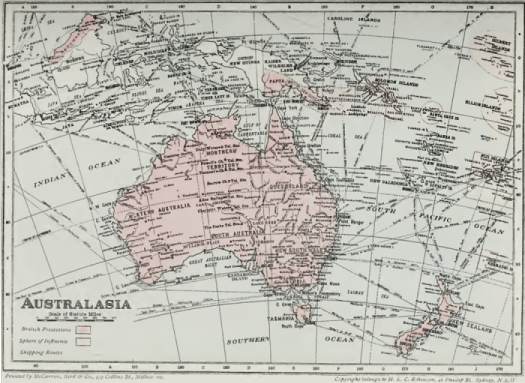CHAPTER VIII.ASTRONOMY AND GEODESY IN AUSTRALIA : Part 1.By Pietro Baracchi, F.R.A.S.,Government Astronomer of Victoria.“The Commonwealth of Australia; Federal Handbook, prepared
in connection with the eighty-fourth meeting of the
|

Map of Australasia in 1914[Map Presented Prior to the Early Text by Sir Ernest Scott. pg.xi.] |
This particular document follows very well from my own Southern Astronomical Delights article “The Dawn of Australian Astronomy”, as it details the commonly neglected period during the first fifty years of European settlement. Chapter 1, not presented here, finds the excellent summary of the “History of Australia” written by Sir Ernest Scott (1867-1939), who was the famous Professor of History at the University of Melbourne. This too, adds much broader balance to my earlier work.
Formally produced and sponsored by the Australian Government, this useful Federal Handbook aimed simply to highlight the whole country’s scientific endeavours and achievements. All the book contents was formulated during several preliminary meetings held in March 1914, although the main Australian conference, the eighty-fourth meeting of the British Association for the Advancement of Science, was held in Melbourne during August 1914. Its purpose is stated in the Preface of this 628 pages, that;
“This Handbook,
specially prepared for the use of member’s of the British Association for the
Advancement of Science, at the Australian Meeting of 1914, contains a
series of articles written by persons selected for that purpose by
the Federal Council in Australia. These articles set forth matters
which, it is believed, will be found of interest, and the data of
which are in most cases not readily accessible to general readers
abroad, nor even to those in Australia. Much of the material also
has not hitherto been published.”
It goes on to say:
“The issue of
the Handbook has been made possible by the generosity of the Federal
Government of Australia… The articles were decided upon by the
Federal Council in Australia of the British Association for the
Advancement of Science, in whose name the invitation was made to each
of the writers to contribute. Each author is alone responsible for
all statements made or opinions expressed in his article.”
I have only given Chapter VIII here, as it relates only to the national development of astronomy and geodesy, giving much insight into the nature of these sciences in Australia. This period is also the transition of science in New Zealand, which for several decades until just after WWII, continued to share and develop the sciences.
Most of the written text was by the then Government Astronomer of Victoria, Pietro Paolo Giovanni Ernesto Baracchi (1851-1926), who was once a civil engineer but later became an astronomer. His appointed position at Melbourne Observatory succeeded the more famous and highly competent, Robert Lewis John Ellery (1927-1908) Baracchi had come to Australia from New Zealand in 1876, and importantly, saw and experienced the transition from British control to independency of both countries. Well versed in the discussions on the overall astronomy and geodesy studied in these once separate colonies, he presents a positive, well-balanced and historically useful report of activity.
Much of the earlier text is a grand summary of Australasia, written by prominent Australians. There are extensive early chapters on history, the Aboriginal population, geography, climate, the fauna and flora and geology: before reaching the section on astronomy and geodesy. After this, some of the most important sections focus directly on the economic potential of Australasia and Australia, specifically, agriculture, mining and manufacturing — still the major focus 100 years later in the 21st Century. The papers conclude on education and Australia’s political system.
More interesting to general readers is the section (c) Amateur Astronomy, showing that astronomy was quite prolific in the 19th to early 20th Century — predating much that is written after this time. Baracchi surmises the brilliant and very optimistic view that:
“In the popular mind, amateur efforts are frequently associated with the idea of inferiority, but the persons who will be referred to in this division of Australian Astronomy need not fear that the adjective “amateur” is given to them with any intention on my part of underrating their abilities as astronomers or of placing them and their work in a class below that of officialdom.”
As time permits, I will include a larger summary of some important aspects of the material this document contains. It is made available at part of the missing chapters of astronomical activities in Australia and the people involved in it development. The list of references is particularly useful in searching for other research into the historical discoveries in this Australia.
The text layout of this document is extremely complex, having many different fonts, font size, notations, special or typographical characters and scripts. I have attempted to preserve as much of the original outline as possible. Numbers in [xxx] are pages numbers in the original documents, while those in (xx) are the notes at the end of this section of the document.
Andrew James : 18th October 2014
Last Update : 20th October 2014
Southern Astronomical Delights © (2014)



